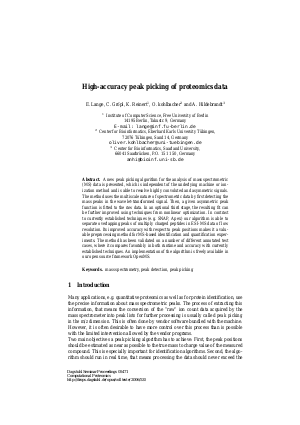High-accuracy peak picking of proteomics data
Authors Eva Lange, Clemens Gröpl, Oliver Kohlbacher, Andreas Hildebrandt
-
Part of:
Volume:
Dagstuhl Seminar Proceedings, Volume 5471
Part of: Series: Dagstuhl Seminar Proceedings (DagSemProc) - License:
 Creative Commons Attribution 4.0 International license
Creative Commons Attribution 4.0 International license
- Publication Date: 2006-05-03
File

PDF
DagSemProc.05471.9.pdf
- Filesize: 102 kB
- 9 pages
Document Identifiers
Subject Classification
Keywords
- Mass spectrometry
- peak detection
- peak picking
Metrics
- Access Statistics
-
Total Accesses (updated on a weekly basis)
0Document
0Metadata
Abstract
A new peak picking algorithm for the analysis of mass spectrometric (MS) data is presented. It is independent of the underlying machine or ionization method, and is able to resolve highly convoluted and asymmetric signals. The method uses the multiscale nature of spectrometric data by first detecting the mass peaks in the wavelet-transformed signal before a given asymmetric peak function is fitted to the raw data. In an optional third stage, the resulting fit can be further improved using techniques from nonlinear optimization. In contrast to currently established techniques (e.g. SNAP, Apex) our algorithm is able to separate overlapping peaks of multiply charged peptides in ESI-MS data of low resolution. Its improved accuracy with respect to peak positions makes it a valuable preprocessing method for MS-based identification and quantification experiments. The method has been validated on a number of different annotated test cases, where it compares favorably in both runtime and accuracy with currently established techniques. An implementation of the algorithm is freely available in our open source framework OpenMS (www.open-ms.de).
Cite As Get BibTex
Eva Lange, Clemens Gröpl, Oliver Kohlbacher, and Andreas Hildebrandt. High-accuracy peak picking of proteomics data. In Computational Proteomics. Dagstuhl Seminar Proceedings, Volume 5471, pp. 1-9, Schloss Dagstuhl – Leibniz-Zentrum für Informatik (2006)
https://doi.org/10.4230/DagSemProc.05471.9
BibTex
@InProceedings{lange_et_al:DagSemProc.05471.9,
author = {Lange, Eva and Gr\"{o}pl, Clemens and Kohlbacher, Oliver and Hildebrandt, Andreas},
title = {{High-accuracy peak picking of proteomics data}},
booktitle = {Computational Proteomics},
pages = {1--9},
series = {Dagstuhl Seminar Proceedings (DagSemProc)},
ISSN = {1862-4405},
year = {2006},
volume = {5471},
editor = {Christian G. Huber and Oliver Kohlbacher and Knut Reinert},
publisher = {Schloss Dagstuhl -- Leibniz-Zentrum f{\"u}r Informatik},
address = {Dagstuhl, Germany},
URL = {https://drops.dagstuhl.de/entities/document/10.4230/DagSemProc.05471.9},
URN = {urn:nbn:de:0030-drops-5358},
doi = {10.4230/DagSemProc.05471.9},
annote = {Keywords: Mass spectrometry, peak detection, peak picking}
}
